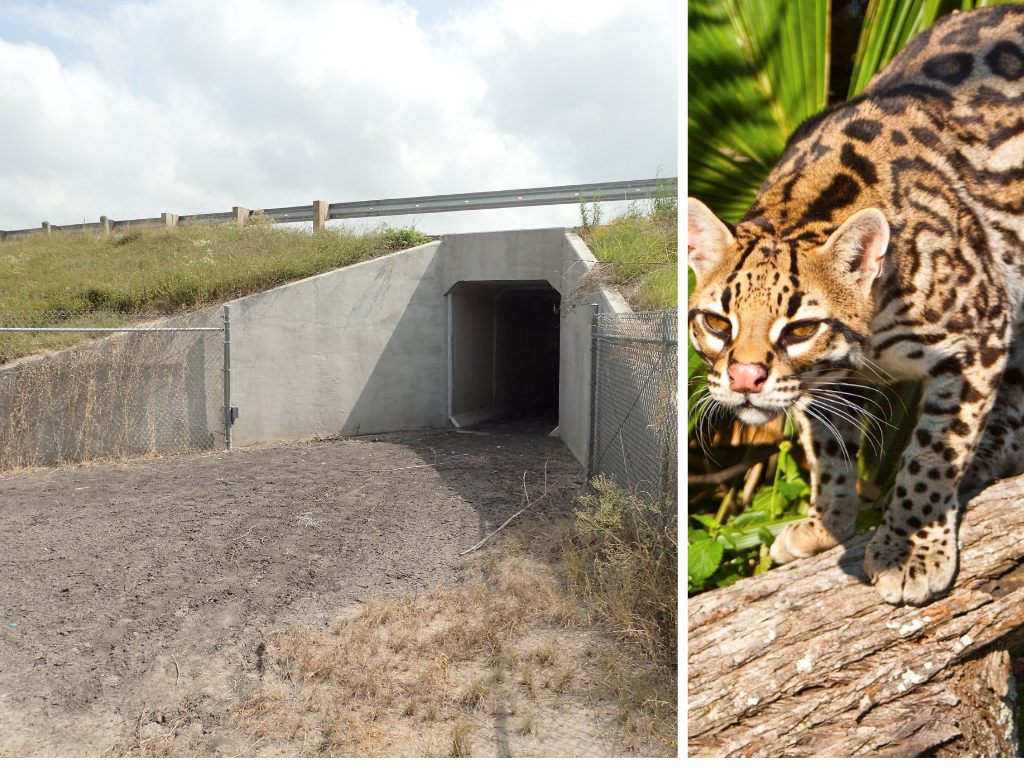
ADVOCACY
Wildlife Corridors And The National Wildlife Refuge System
A wildlife underpass at Laguna Atascosa National Wildlife Refuge, TX offers safe passage to endangered ocelots and other small mammals and makes roads safer for motorists | Left photo: Mitch Sternberg / USFWS; Right photo: Larry Ditto / USFWS
Wildlife corridors are spans of protected land that allow mammals, birds, and amphibians to move freely and safely as they complete their life cycle. This includes everything from large stopover areas for migratory birds, small road underpasses to protect endangered ocelots, and the removal of dams to improve stream conditions for salmon. No matter the reason, the National Wildlife Refuge System plays a critical role in creating corridors to support wildlife.
Chinook salmon | Ryan Hagerty / USFWS
National wildlife refuges play a dual role in establishing wildlife corridors. There can be corridors within national wildlife refuges, where certain tracts of land are critical in establishing a connection between habitats. National wildlife refuges themselves can also be connected to other conserved lands and serve as a piece of a larger wildlife corridor system. In both cases, the protections afforded by the designation and management of a national wildlife refuge create a safe haven for wildlife on the move.
The National Wildlife Refuge Association engages in extensive advocacy to provide the Refuge System with funding to purchase land, create conservation easements with interested landowners, and engage with the surrounding community. This funding primarily comes through the Land and Wildlife Conservation Fund (LWCF) and the National Wildlife Refuge System’s Operations and Maintenance fund.
A Resiliency Tool
Black bear at Alligator River National Wildlife Refuge, NC | Jackie Orsulak / USFWS
As the world feels the aggressive impacts of climate change like drought, temperature increases, shifting landscapes, and sea-level rise, we must become more resilient to protect against these threats. Wildlife corridors are a great tool to build climate resilience. As species move away from their traditional habitats to find food and water and escape higher temperatures, they need safe passage to protected areas. Wildlife corridors create this safe passage and reduce the risk of losing valuable wildlife to the pressures of climate change. Highways, development pressure, and private land transactions inhibit the ability of wildlife to move between protected areas and expose them to unnecessary risk.
The effects of climate change are already here and are something the Refuge System should plan on feeling more intensely each year. Mitigation efforts now will show results down the line, but action must be taken now to protect vulnerable wildlife. This is a relatively straightforward resiliency tool that can be deployed but will require significant funding. The National Wildlife Refuge System purchases land at market value, and many critical areas are large in size and expensive to purchase outright.
Everglades Headwaters National Wildlife Refuge
Florida panthers crossing the road near Big Cypress National Preserve and Florida Panther National Wildlife Refuge, FL | Peter Matthews / Big Cypress National Preserve
Everglades Headwaters National Wildlife Refuge in South Florida is a prime example of the potential benefit of wildlife corridors. Everglades Headwaters NWR encompasses 150,000 acres north of Lake Okeechobee and supports unique species like the endangered Florida panther along with 88 other listed species. Although the Everglades Headwaters NWR is large in size, important tracts of land remain in the hands of private landowners. Purchasing these lands using funding from the LWCF would connect large swaths of the Everglades Headwaters NWR and create a corridor for vulnerable wildlife.
Florida is considered the most vulnerable state in the nation to the impacts of climate change and action must be taken to ensure its’ wildlife has protection from extinction threats. In order to conserve the lands needed within Everglades Headwaters NWR, $20 million is needed from the LWCF. The National Wildlife Refuge Association supports increased funding for the purchase of land in order to create this important corridor, along with other corridors across the National Wildlife Refuge System. We encourage you to write to your Representatives and advocate for the establishment of wildlife corridors.




